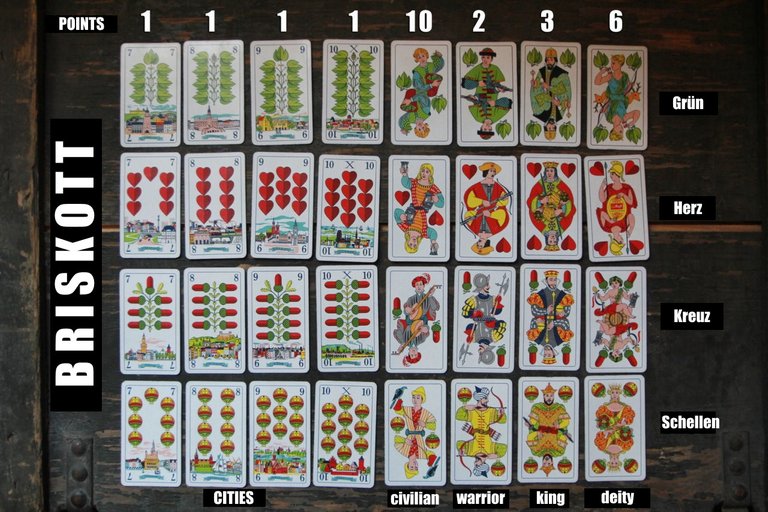Playing Briskott requires a traditional Skat (German-suited) deck made of 32 cards: 16 city cards (valued from 7 to 10), 4 civilian cards, 4 warrior cards, 4 king cards and 4 deity cards. They are divided into four colour suits: Kreuz (clubs/acorns), Grün (spades/leaves), Herz (hearts), and Schellen (diamonds/bells). The weakest cards during a play are the cities while the deity cards are the strongest.
Each game begins with shuffling the deck and dealing 4 cards to each player. Additionally, one card is revealed and placed on the table under the card pile so that everyone can see it. The card is now called the Briskott and will be drawn last.
During each round, the players (in clockwise order) play one card. The suit (card colour) played by the first player becomes the leading trump suit. To win a round, a player has to play a card with a higher value matching the trump suit or any card from the Briskott suit.
Examples: The Briskott is a Grün. Player 1 plays a 10 of Herz. If he wants to win the round, Player 2 has to play a stronger Herz card (civilian, warrior, king, deity) or any card from the Briskott suit (Grün).
The player who has won the round takes all cards and is the first to draw another card from the pile and start a new round. The game continues until all cards have been played. When it ends, the points are counted for each player. What makes Briskott unique is that the card with the highest score value is not the deity, but the civilian. The scoring system looks as follows: civilian—10 points, deity—6 points, king—3 points, warrior—2 points, city—1 point. The total number of score points is 100.
For the 3-player variant of the game, two random 7 cards must be removed from the deck. The players play against each other.
For the 4-player variant, the players form two teams. Each player should have an opponent on his left and right side, and his partner in front of him. After drawing the final 4 cards from the pile the players can exchange their decks with their partners and see them. During the play, it is allowed to talk about the cards on hand.

Briskott cards
All tournaments of the Royal Briskott League require the use of a card deck designed by Franciszek Bunsch in 1963. Its cards are different from the French-suited cards (the most popular pattern in Poland) which may cause certain difficulties.
The most popular question concerns court cards. How to distinguish a civilian from a warrior? How to tell the difference between a deity and a king?
CIVILIAN:
- friendly-looking and unarmed (instead, he holds a mandolin, falcon, tankard, or a bunch of grapes,
- has 2 suit symbols placed near the centre of the card.
WARRIOR:
- armed (with a musket, crossbow, halberd, or a bow),
- has 2 suit symbols placed in the corners.
KING:
- wears a crown
- is a man,
- has 4 suit symbols placed vertically in card corners.
DEITY:
- usually is a woman (except Bacchus),
- has 4 suit symbols placed diagonally in card corners.
The picture above shows a complete deck of Briskott cards. They are presented from the weakest (7) to the strongest one (deity). However, we must remember that the highest-scoring card is the civilian (10) and not the deity (6).
Wow. These cards are very similar to the Hungarian playing cards. Both their looks and their quantity too (32 cards).
Yay! 🤗
Your content has been boosted with Ecency Points, by @bezkresu.
Use Ecency daily to boost your growth on platform!
Support Ecency
Vote for new Proposal
Delegate HP and earn more
I still think grapes are weapons😂
In Polish language GRANAT means "pomegranate" and also "grenade", so with this you could think so but not with grapes ;)